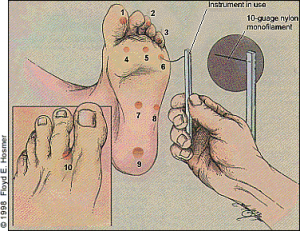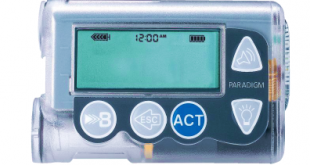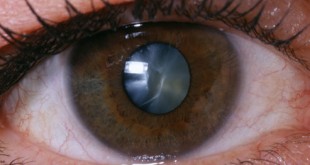Introduction
Monofilament examination is used to assess high risk foot for diabetes foot ulcers. It is to assess pressure sensation perception.
It is reliable in screening for patients at risk of foot ulceration because sensitivity is a more important parameter [1]. Monofilament examination is inexpensive and non invasive.
What Is Monofilament Examination?
Monofilament sometimes known as Semmes-Weinstein monofilaments is commonly used to assess foot at risk of ulceration [2]. The nylon monofilament is constructed to buckle when a 10 gram force is applied.
 Diagram 1: Monofilament test [5]
Diagram 1: Monofilament test [5]
What Does It Test?
Various prospective studies have confirmed that loss of pressure sensation using the 10 gram monofilament is highly predictive of subsequent ulceration [3, 4]. The 10 gram monofilament is efficacious in screening sensory loss and is used widespread across the world.
Loss of the ability to detect the 10 gram pressure at one or more anatomic sites on the plantar surface of the foot has been associated with loss of large-fibre nerve function.
Monofilament examination is recommended at four sites (first, third and fifth metatarsal heads – points 1,2 and 3 in the diagram above and plantar surface of distal hallux – great toe). Test should be done on both feet and at least annually.
How to Do the Test?
Patient should be informed of the test, objective and how it is going to be done. The sensation of pressure using the buckling 10 gram monofilament should first be demonstrated to the patient on a proximal site.
The sites of the foot may then be examined by asking the patient to respond “yes” or “no” when asked whether the monofilament is being applied to the particular site. Patient should recognize the perception of pressure as well as identify the correct site.
Areas of callus or thickened skin must be avoided. Eyes should be closed during the monofilament examination.
Who Should Do The Test?
Health care providers must ensure monofilament test is done in all diabetes patients. Trained staff nurses and assistant medical officers are competent to conduct the test.
Conclusion
Monofilament examination assesses pressure perception in the feet. It is aimed to detect high risk feet for ulceration in diabetes patients. Early detection can prevent amputation.
References
- Armstrong, David G.; Lavery, Lawrence A Diabetic Foot Ulcers: Prevention, Diagnosis and Classification. AmFam Physician.1998 ; 57(6):1325-
- Kumar et al. Semmes-Weinstein monofilaments: a simple, effective and inexpensive screening device for identifying diabetic patients at risk of foot ulceration. Diabetes Research and Clinical Practice 1991; 13(1-2): 63-7.
- Mayfield JA, Sugarman JR: The use of the Semmes-Weinstein monofilament and other threshold tests for preventing foot ulceration and amputation in persons with diabetes. J FamPract 2002; 49 (Suppl. 11): S17–S29.
- Singh N, Armstrong DG, Lipsky BA: Preventing foot ulcers in patients with diabetes. JAMA 2005; 293:217–228.
 PENDIDIKAN PESAKIT Kementerian Kesihatan Malaysia
PENDIDIKAN PESAKIT Kementerian Kesihatan Malaysia



